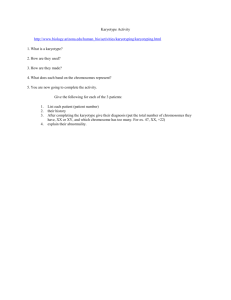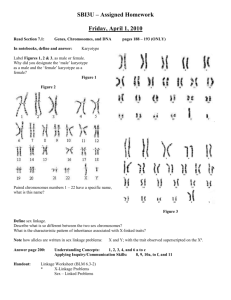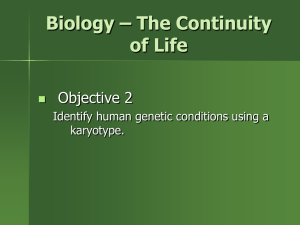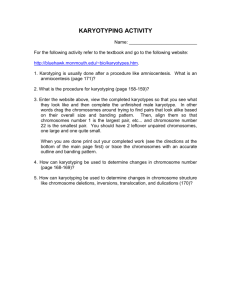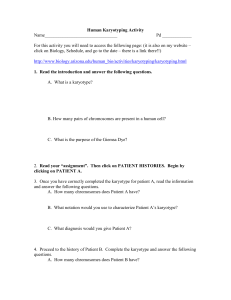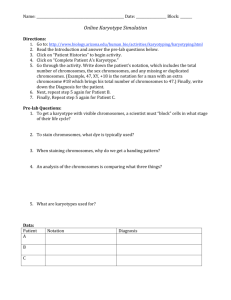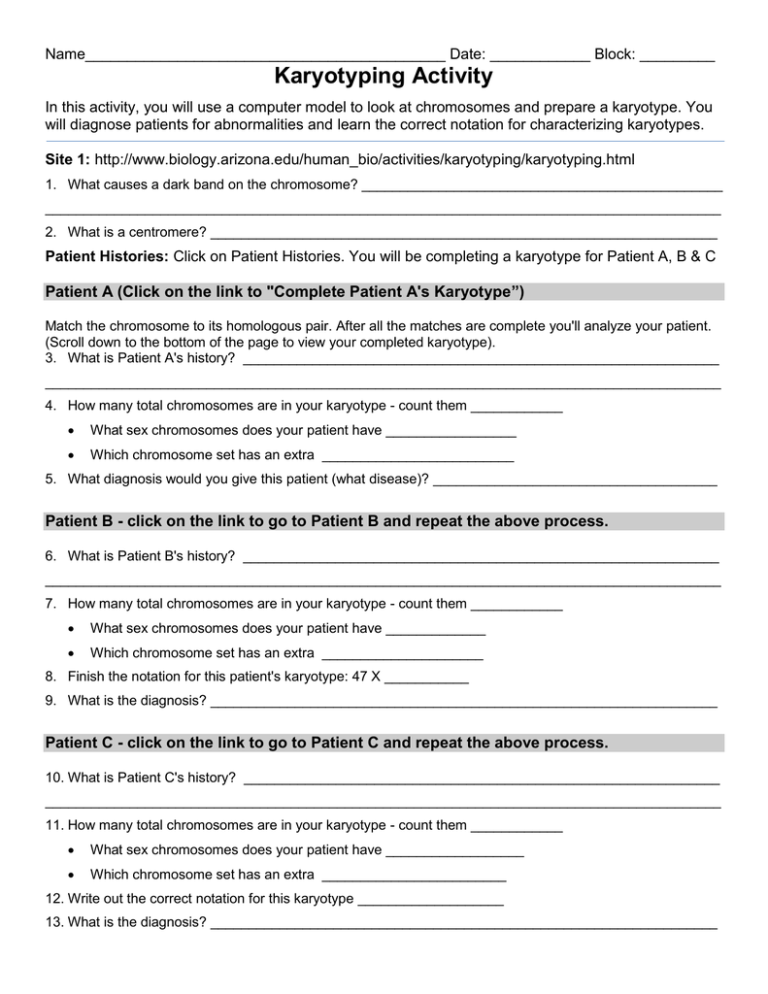
Name___________________________________________ Date: ____________ Block: _________
Karyotyping Activity
In this activity, you will use a computer model to look at chromosomes and prepare a karyotype. You
will diagnose patients for abnormalities and learn the correct notation for characterizing karyotypes.
Site 1: http://www.biology.arizona.edu/human_bio/activities/karyotyping/karyotyping.html
1. What causes a dark band on the chromosome? _______________________________________________
________________________________________________________________________________________
2. What is a centromere? __________________________________________________________________
Patient Histories: Click on Patient Histories. You will be completing a karyotype for Patient A, B & C
Patient A (Click on the link to "Complete Patient A's Karyotype”)
Match the chromosome to its homologous pair. After all the matches are complete you'll analyze your patient.
(Scroll down to the bottom of the page to view your completed karyotype).
3. What is Patient A's history? ______________________________________________________________
________________________________________________________________________________________
4. How many total chromosomes are in your karyotype - count them ____________
What sex chromosomes does your patient have _________________
Which chromosome set has an extra _________________________
5. What diagnosis would you give this patient (what disease)? _____________________________________
Patient B - click on the link to go to Patient B and repeat the above process.
6. What is Patient B's history? ______________________________________________________________
________________________________________________________________________________________
7. How many total chromosomes are in your karyotype - count them ____________
What sex chromosomes does your patient have _____________
Which chromosome set has an extra _____________________
8. Finish the notation for this patient's karyotype: 47 X ___________
9. What is the diagnosis? __________________________________________________________________
Patient C - click on the link to go to Patient C and repeat the above process.
10. What is Patient C's history? ______________________________________________________________
________________________________________________________________________________________
11. How many total chromosomes are in your karyotype - count them ____________
What sex chromosomes does your patient have __________________
Which chromosome set has an extra ________________________
12. Write out the correct notation for this karyotype ___________________
13. What is the diagnosis? __________________________________________________________________
Site 2: Genetic Science Learning Center http://learn.genetics.utah.edu/
Go to: "Chromosomes and Inheritance"
"How Do Scientists Read Chromosomes"
Find the answers to the following questions by browsing all sections in this area.
1. What are the three key features used to read chromosomes? __________________________,
________________________________, and _________________________________________.
2. Sketch and describe: metacentric, submetacentric, acrocentric
Go back to: "Chromosomes and Inheritance"
"Make a Karyotype"
Create your own karyotype (turning on hints is okay). Check this box when your karyotype is
completed to verify your attempt.
3. What did you find difficult about matching the chromosomes? _____________________________
Go back to: "Chromosomes and Inheritance"
"Using Karyotypes to Diagnose Genetic Disorders"
4. What is trisomy? ________________________________________________________________
5. What is monosomy? _____________________________________________________________
6. What is a terminal deletion? _______________________________________________________
Understanding Disorders
Briefly describe the chromosome abnormality and the symptoms for the following disorders. Type
each of the following disorders into the search box at the top of the Learn Genetics website.
Cri Du Chat
Turner Syndrome
Klinefelter Syndrome
Williams Syndrome

